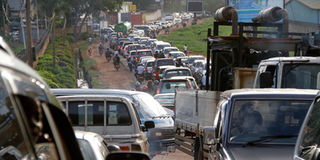Prime
Why your vehicle consumes more fuel in urban areas than highways

Frequent stops and change of speed and gears at traffic lights and in traffic jam is the reason one is likely to consume more fuel in urban centres than on highways. Photo by Abubaker Lubowa.
What you need to know:
- It is true that a vehicle will consume more fuel in an urban area which is traffic jam ridden causing the motorist to stop and start numerous times as opposed to driving on the highway, where the speed is steady and there are hardly any stopovers. Here’s why this is so.
There is no doubt that it is every motorist’s desire to cover as much distance as they can using as little amounts of fuel as possible.
This partly explains why motorists consider key features like a vehicle’s fuel consumption or engine size when buying a car.
For example, to cover the approximately 270km distance from Kampala to Mbarara in his 3000cc engine size sport utility vehicle (SUV) Land Rover Discovery 4, Jimmy Kutosi, a motorist needs only Shs70,000 to buy approximately 18 litres of diesel fuel, going by a rate of Shs3,900 per litre, fuel he says is enough without adding any other along the way to complete the journey.
According to Kutosi, this is possible because his car burns one litre of fuel to cover 14 kilometers on a highway compared to towns or cities with busy traffic jam where the same car uses one litre to cover 10 kilometers. This means that he loses four litres of fuel while driving in traffic jam.
Difference in gears
Similarly, when Francis Kavuma, a long distance motorist drives his Toyota Super Custom on a highway, he burns one litre of fuel to cover seven kilometers, whereas in towns or areas with traffic jam, the same car burns one litre of fuel to cover five and a half litres of fuel.
He explains that the difference in these trends is that on a highway, the car is fast and drives on high gears, four, five and six where the engine becomes light. Whereas in traffic jam, a Super Custom drives on low gears, one, two and three, gears he says are somewhat heavy on the a car engine.
Patrick Kamara, also a motorist weighs in on the matter, observing that when on a highway, his Toyota Premio burns one litre to cover a distance of approximately 14 kilometers and one litre to drive approximately 10 to 12 kilometers while driving in areas with high traffic. His reasoning in fuel consumption trends on highways vis-à-vis areas with heavy traffic is similar to Kavuma’s.
According to Jimmy Sserwadda, the above trends of your vehicle consuming more fuel in traffic jam than it does when on a highway can be explained in a number of ways. However, this varies from one vehicle or brand to another, which is also primarily dependent on the vehicle’s engine size.
Stopping and braking
The fact that driving in urban areas with high traffic volumes means that you will have to make lots of stopovers at different points. If it is not at traffic lights where you completely come to a full stop, it will be at a zebra crossing.
It could as well be at a junction with many vehicles going to different directions or pedestrians crossing the road even at ungazetted points.
High fuel urban consumption is also attributed to the numerous roads that sometimes come with making turns, which means that you have to slow down your speed in order to negotiate a turn or corner successfully.
“When you have been stopped at traffic lights and you are eventually released, it means you will have to accelerate from zero to a reasonable speed mark to pick up speed again. This motion will require the engine to use a reasonable amount of fuel to increase driving speed.
The harder you accelerate, the more your engine will burn fuel to pick up the appropriate speed. This will happen in low and heavy car gears (one, two and three) that use a lot of fuel yet the maximum speed in urban areas is 50km/hour,” Sserwadda explains.
Whereas you mostly accelerate in areas with traffic jam, the order of the day while driving on highways is maintaining different high speeds with no traffic lights and very few or no zebra crossings at all.
Turning off the engine
Much as motorists like Eric Makanga turn off their engines, most times they are caught up in traffic jam, Musa Kimera, a mechanic at Wandegeya explains that switching off your engine in traffic jam renders it idle and cold. This means that when you turn the ignition key later when traffic moves, your engine will take up more fuel to rewarm it as opposed to if it was left running.
Kimera is of a view that instead of switching of your engine, it is instead recommended to shift the gear lever in neutral or parking mode and leave the engine turned on so that it does not use much fuel to warm up.
According to www.antwerpentoyota.com an online portal, hybrid vehicles are an exception to when cars consume more in high traffic areas compared to highways, however. Unlike traditional gas engine automobiles, hybrids get better gas mileage in the city than the highway. The reason for the difference is regenerative braking. Regenerative braking was developed in the 1990s, and harnesses the energy generated during braking and returns it to the battery, providing the energy the vehicle can use to power the car. Because this reduces the energy needed from the gasoline engine, it improves fuel economy.




